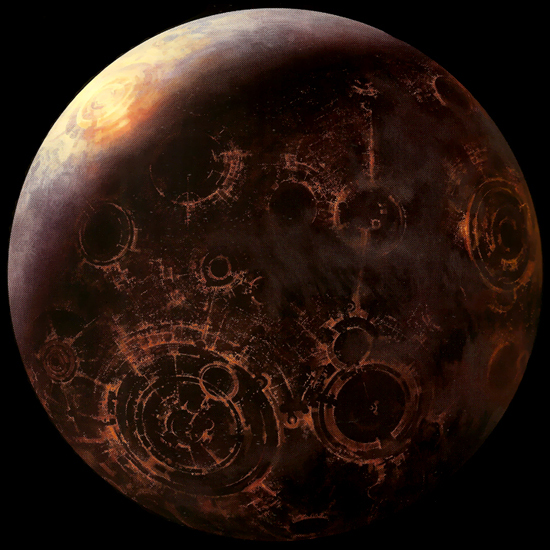Coruscant
World
Coruscant
| |
|---|---|

| |
| Astrographical | |
|
Region | Core Worlds |
|
Sector | Coruscant Sector |
|
System | Coruscant System |
|
Orbital Position |
6 |
|
Sun(s) | |
|
Moon(s) |
Four natural satellites: Many artificial satellites: |
|
Grid Coordinates |
L-9 |
|
XYZ coordinates |
0,0,0 |
|
Distance from Core |
10,000 light years |
|
Rotation period |
24 standard hours |
|
Orbital period |
368 local days |
| Physical | |
|
Class |
Terrestrial |
|
Diameter |
12,240 km |
|
Atmospher | Type I (breathable) |
|
Climate |
Temperate and Controlled |
|
Gravity |
Standard (near 9.81 m/s2) |
|
Primary Terrain |
|
|
Points of interest |
|
| Societal | |
|
Native species |
|
|
Immigrated Species |
Various |
|
Primary Language(s) |
|
|
Government |
|
|
Population |
Official census: 1 trillion permanent ground residents
Additional amount of transients, temporary workers, unregistered populace, residents of orbital facilities |
|
Demonym | Coruscanti |
|
Major cities |
|
|
Major imports |
|
|
Major exports |
|
|
Ancient Affiliations |
|
|
Recent Affiliations |
|
Coruscant (pronounced /'kɔɹəsɑnt/), originally called Notron, also known as Imperial Center or the Queen of the Core, was a planet located in the Galactic Core. It was generally agreed that Coruscant was, during most of galactic history, the most politically important world in the galaxy. At various times, it was the capital of the Galactic Republic, and the Galactic Empire. In controlling Coruscant, these governments controlled most of the galaxy in the process.
Over the centuries, Coruscant had developed into an ecumenopolis. The actual planet-wide metropolis of Coruscant was called Galactic City. Under the Galactic Republic, the names Republic City or the City of Spires were also used to reference the city. It was also called Imperial City under the Galactic Empire. However, in practice, Galactic City and its other names were sometimes applied to the Senate District, the central government center and de facto capital of Coruscant.
Geography
-
History
-